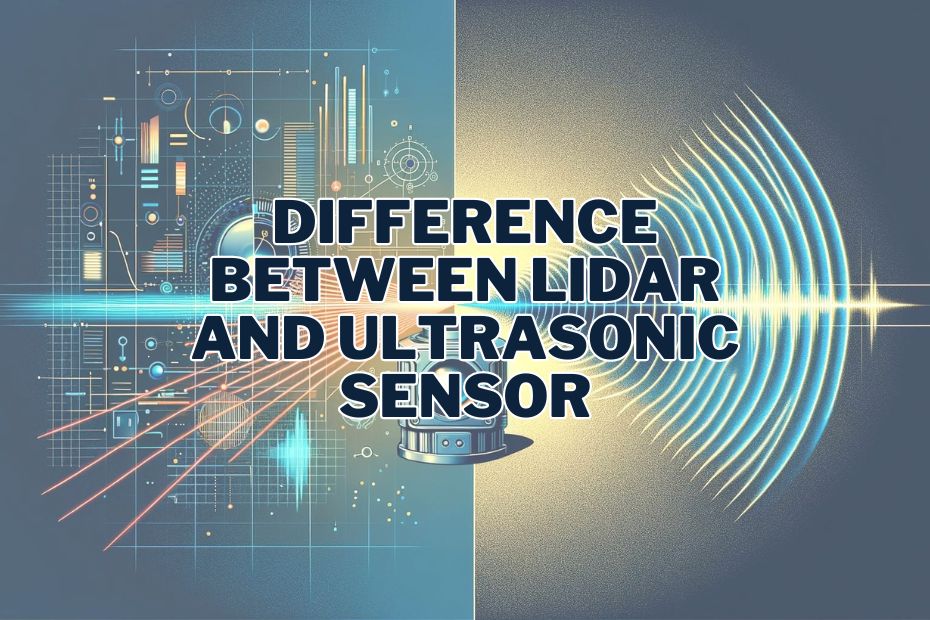In the realm of sensing technology, LiDAR and ultrasonic sensors have emerged as two prominent players, each with its unique capabilities and applications. As the demand for precise distance measurement and object detection continues to grow across various industries, understanding the differences between these two technologies is crucial for making informed decisions. In this comprehensive guide, we delve into the difference between LiDAR and ultrasonic sensors, shedding light on their working principles, applications, and advantages.
LiDAR and Ultrasonic Sensors differ in their core technology. LiDAR uses laser pulses for precise long-range measurements, ideal for autonomous vehicles and 3D mapping. Ultrasonic Sensors rely on sound waves for shorter-range measurements, cost-effective for parking assist systems and object detection. Choose based on your application’s range and precision needs.
Understanding LiDAR Technology
LiDAR technology, a staple in geographic information systems, operates by emitting light pulses and measuring the time it takes for the reflected light to return. This process enables the creation of precise three-dimensional representations of the surveyed area. LiDAR’s applications are extensive, ranging from creating detailed topographic maps to aiding autonomous vehicles in navigation. Explore more about the versatile uses of LiDAR in LiDAR vs Photogrammetry and LiDAR in Autonomous Vehicles.
Key Characteristics of LiDAR
- Range and Accuracy: LiDAR sensors can cover longer distances with high accuracy, making them ideal for mapping large areas.
- Light-based Technology: Utilizes laser light, allowing for operation in various lighting conditions, including nighttime as discussed in Does LiDAR Work at Night?
- Applications: Extensively used in geography, remote sensing, and even in detecting landmines, as detailed in Can LiDAR Detect Landmines?
The Role of Ultrasonic Sensors
Contrasting LiDAR, ultrasonic sensors rely on sound waves to detect objects and measure distances. These sensors emit ultrasonic sound waves and calculate the distance by timing the echo received after bouncing off an object. Their common use is in proximity sensing, such as in parking sensors and robotics.
Key Features of Ultrasonic Sensors
- Short Range Sensing: More effective for short-range applications.
- Sound-based Technology: Operates using sound waves, which can be influenced by environmental factors like wind.
- Diverse Applications: From robotics to vehicle systems, ultrasonic sensors have a broad range of uses.
Difference Between LiDAR and Ultrasonic Sensor
Both LiDAR and ultrasonic sensors play pivotal roles in the field of spatial technology. Their diverse applications range from mapping and surveying landscapes to enhancing the functionality of autonomous systems. Understanding their differences is key to choosing the right technology for your specific needs.
Detailed Comparisons: Performance in Various Environments
While LiDAR excels in mapping and high-precision tasks, its performance can be affected under certain conditions. For instance, LiDAR sensors might struggle in foggy or dusty environments, as explored in Does LiDAR Work in Fog?. In contrast, ultrasonic sensors are less sensitive to visual obstructions, but their performance can be influenced by acoustic disturbances or extreme temperatures.
LiDAR in Challenging Conditions
- Fog and Dust: Light scattering in foggy conditions can reduce LiDAR’s effectiveness.
- Night Operations: LiDAR operates efficiently in low light, as it does not rely on ambient light.
Ultrasonic Sensor Limitations
- Acoustic Interference: Sound-based detection can be hampered by ambient noise.
- Temperature Effects: Extreme temperatures can affect the speed of sound, impacting sensor accuracy.
Technological Evolution and Future Trends
The evolution of both LiDAR and ultrasonic technologies is ongoing, with advancements aimed at overcoming their respective limitations. The integration of these sensors in complex systems, such as autonomous vehicles, highlights the need for continuous improvement. For insights into this evolution, consider LiDAR vs Radar and LiDAR vs LADAR.
Future Directions
- Enhanced Accuracy: Ongoing research aims to improve the precision and range of both technologies.
- Integration with Other Technologies: Combining LiDAR with other sensors, like radar and cameras, to compensate for individual limitations.
Cost and Implementation Considerations
The decision between LiDAR and ultrasonic sensors also hinges on cost and ease of implementation. While LiDAR systems are typically more expensive, their precision and range might justify the investment for certain projects. Ultrasonic sensors, being more affordable, are a practical choice for budget-conscious applications.
Cost-Benefit Analysis
- LiDAR: Higher initial cost but offers detailed data and long-range capabilities.
- Ultrasonic: More affordable, suitable for short-range, simple tasks.
Integration in Industry-specific Applications
Both LiDAR and ultrasonic sensors find their unique places in various industries, driven by their specific characteristics. For instance, LiDAR’s precision in 3D mapping is invaluable in geography and cartography, as detailed in LiDAR vs DEM (Digital Elevation Models). Similarly, the simplicity and cost-effectiveness of ultrasonic sensors make them a popular choice in consumer electronics and basic proximity detection systems.
Industry Examples
- Geographic Information Systems: LiDAR’s detailed mapping capabilities are essential for creating accurate geographic models.
- Automotive Industry: Ultrasonic sensors are widely used in vehicle parking assistance systems.
The Role of Innovation and Research
The future of these technologies is shaped by ongoing research and innovation. As new applications emerge, both LiDAR and ultrasonic sensors are being adapted and improved to meet evolving demands. This constant innovation ensures that both technologies remain relevant and effective in their respective domains.
Research and Development
- LiDAR: Research focuses on enhancing range and resolution, as well as reducing costs.
- Ultrasonic: Efforts aim to improve accuracy and reduce susceptibility to environmental factors.

The visualization compares LiDAR and Ultrasonic sensors across five criteria: Range, Accuracy, Cost, Environmental Sensitivity, and Implementation Ease. Each criterion is scored out of 10. LiDAR scores higher in Range and Accuracy, reflecting its longer distance coverage and precision. However, it scores lower in Cost, indicating a higher price point. In Environmental Sensitivity and Implementation Ease, LiDAR and Ultrasonic have closer scores, with Ultrasonic leading slightly in Cost and Implementation Ease, suggesting it’s more budget-friendly and easier to implement.
Comparing Technologies: When to Use Which?
The choice between LiDAR and ultrasonic sensors largely depends on the specific requirements of a project. LiDAR’s high accuracy and long-range capabilities make it suitable for detailed geographic mapping and autonomous vehicle technology. In contrast, ultrasonic sensors, with their short-range proficiency, are ideal for applications like object detection in robotics or vehicle reverse parking systems.
Factors to Consider
- Distance and Precision: For long-distance and high-precision needs, LiDAR is preferable.
- Cost and Complexity: Ultrasonic sensors are generally more cost-effective and simpler to implement.
- Environmental Suitability: LiDAR performs well in various lighting conditions, whereas ultrasonic sensors can be affected by environmental factors.
Conclusion:
In the debate of LiDAR vs ultrasonic sensors, there is no one-size-fits-all answer. The choice between these technologies depends on your specific needs and budget constraints. LiDAR excels in precision and 3D mapping, making it a top choice for autonomous vehicles and environmental applications. On the other hand, ultrasonic sensors offer a cost-effective solution for obstacle detection, parking assistance, and level sensing.
Remember that successful implementation depends on understanding the differences and selecting the technology that aligns with your objectives.
FAQs: Difference Between LiDAR and Ultrasonic Sensor
Can LiDAR sensors work in adverse weather conditions?
LiDAR sensors may face challenges in heavy rain or fog, affecting their performance.
Are ultrasonic sensors suitable for outdoor use?
Ultrasonic sensors can be used outdoors, but their range and accuracy may vary depending on environmental factors.
Which technology is better for autonomous vehicles?
LiDAR is commonly used in autonomous vehicles due to its high precision and 3D mapping capabilities.
Do ultrasonic sensors have any limitations in terms of object detection?
Ultrasonic sensors may struggle to detect soft or absorbent surfaces effectively.
Are LiDAR sensors safe for use around humans?
Yes, LiDAR sensors are safe for human use as they use invisible infrared light.
Which sensor is better for long-range applications?
LiDAR sensors are better suited for long-range applications, offering accurate measurements beyond 100 meters.
